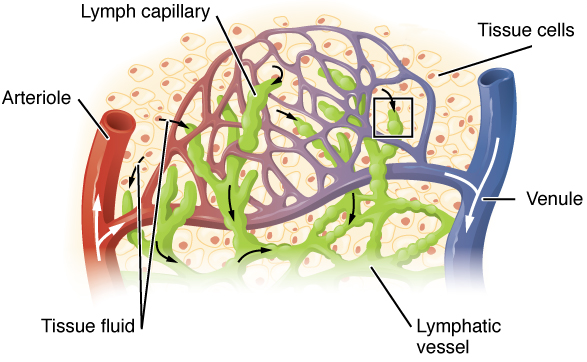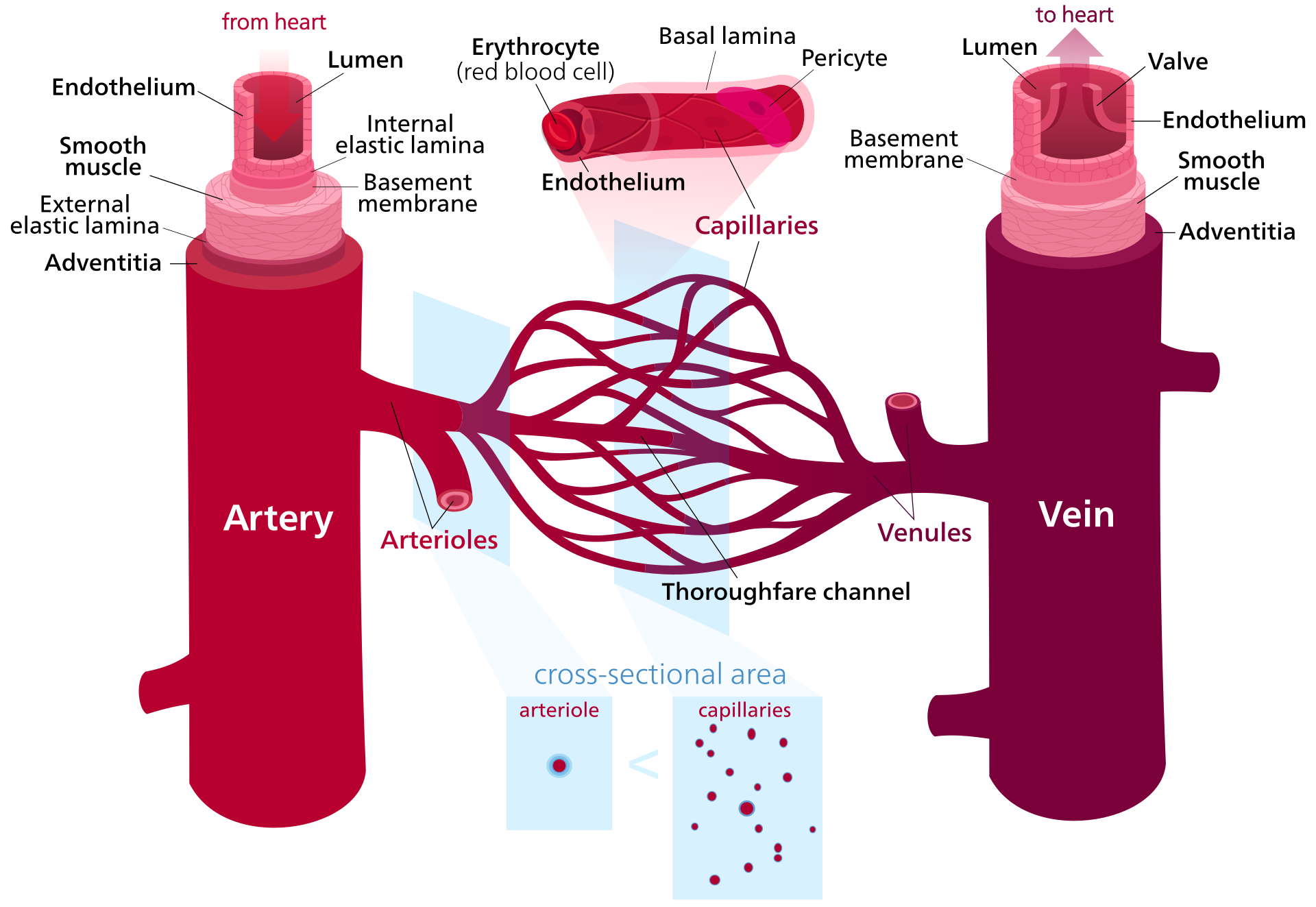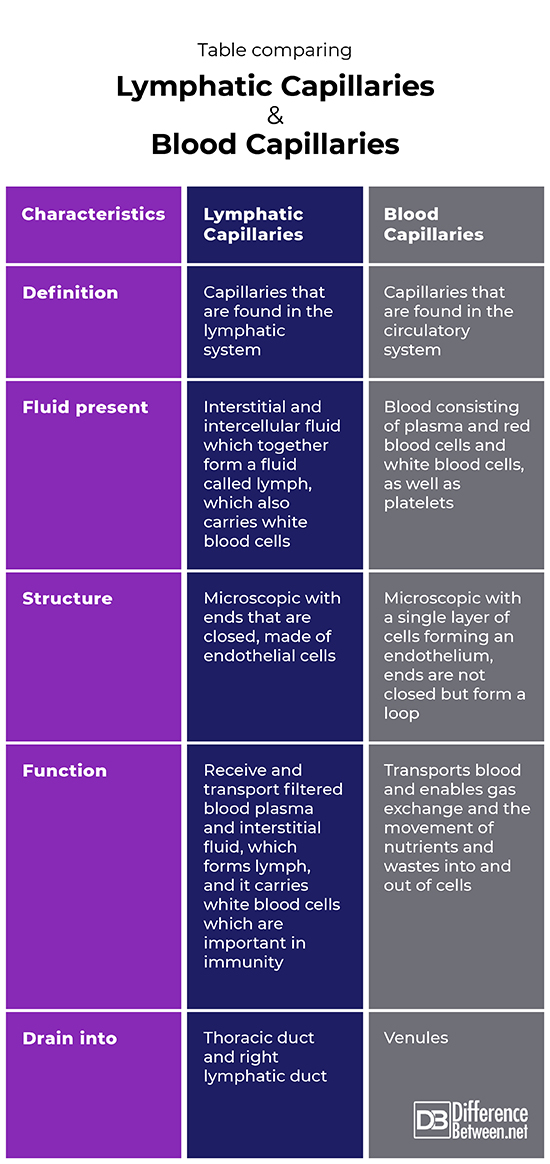Difference Between Lymphatic Capillaries and Blood Capillaries
Lymphatic capillaries are the tiny vessels of the lymphatic system that carry lymph. Blood capillaries are the smallest blood vessels of the circulatory system and they carry blood.

What are Lymphatic capillaries?
Definition:
These are the smallest vessels of the lymphatic system, which transport fluid known as lymph. The lymph is formed from plasma that has leaked from blood capillaries along with tissue fluid.
Location in the body:
Lymphatic capillaries are found throughout the body except for a few places, namely, the epidermis, mucous membranes like the mouth, the central nervous system and in the marrow of the bones. Other parts of the body have very high densities of such capillaries, namely, the intestines, skin dermal layer and the urinary and genital system.
Structure:
A lymphatic capillary is a microscopic structure that is comprised of one layer of cells called the endothelium. Spaces between these endothelial cells can increase in size to allow fluid to enter into the capillary. There are also extensions from the capillaries that help to keep them anchored into surrounding tissues.
Function:
The lymphatic capillaries carry interstitial fluid that often is derived from blood plasma that leaks out of blood vessels. The fluid also contains some oxygen, amino acids and glucose that cells can use, and white blood cells that are important in the immune response. These fluids are often recycled and sent back into the blood vessels. The capillaries all drain into one of two large vessels of the lymphatic system that are known as trunks. These are the right lymphatic duct and the thoracic duct.

What are Blood capillaries?
Definition:
Blood capillaries are the tiniest blood vessels of the circulatory system that occur between arteries and veins.
Location in the body:
Blood capillaries are found throughout the body, surrounding all the cells so as to ensure an adequate oxygen and nutrient supply to the tissues. The type of capillary varies according to where it is located, for instance, those in the brain form part of the blood-brain barrier and are of different anatomy than other capillaries which occur elsewhere in the body.
Structure:
The size of blood capillaries is microscopic and, in general, they are only up to about 10µm in diameter. The capillaries consist of a single layer of endothelial cells. There are three types of capillaries, namely, continuous, fenestrated, and sinusoid. The continuous type is found in the brain and does not have spaces between the cells so as to prevent toxins from entering nerve cells. The sinusoid capillaries occur in the spleen and liver and allow the most substances to leak through. The fenestrated type is found in other parts of the body and allows some, but not as many, substances to leak through the spaces between cells.
Function:
The blood capillaries surround all the cells of the body and they are thin walled to allow the exchange of substances between the blood and the cells. This means that oxygen and carbon dioxide can be exchanged and so can nutrients and wastes. The blood capillaries also form an important connection between the venous and arterial systems of the body by connecting arterioles to venules. Precapillary sphincters regulate the flow of blood through capillary beds so as to control blood flow to different parts of the body.
Difference between Lymphatic capillaries and Blood capillaries?
Definition
Lymphatic capillaries are those that are found in the lymphatic system. Blood capillaries are those that are found in the circulatory system.
Fluid present
Lymph is the fluid present in the lymphatic capillaries, which is made up of intercellular and interstitial fluid and white blood cells. Blood is the fluid present in the blood capillaries, which also contains cellular components.
Structure
The lymphatic capillaries have closed ends and consist of endothelial cells forming one layer. The blood capillaries form a loop and consist of a single layer of endothelium.
Function
The function of lymphatic capillaries is to receive and transport any filtered blood plasma and interstitial fluid, these fluids form the lymph which is often returned to the blood vessels, and it carries white blood cells for immunity. The function of blood capillaries is to transport blood and thus, enable gas exchange and the movement of nutrients and wastes into and out of cells.
Drain into
The lymphatic capillaries drain into the thoracic duct and into the right lymphatic duct. The blood capillaries drain into the venules which then carry blood into the veins which, in the systemic circulation, return blood to the heart.
Table comparing Lymphatic capillaries and Blood capillaries

Summary of Lymphatic capillaries Vs. Blood capillaries
- Both lymphatic capillaries and blood capillaries are microscopic structures that carry fluid.
- Both lymphatic and blood capillaries are the smallest vessels in the lymphatic and circulatory systems, respectively.
- Lymphatic capillaries carry fluid called lymph, which is largely formed from plasma that has leaked out of blood vessels, and it carries cells of the immune system.
- Blood capillaries carry blood which consists of both red and white blood cells, platelets, and the fluid component, the plasma.
- Difference Between Rumination and Regurgitation - June 13, 2024
- Difference Between Pyelectasis and Hydronephrosis - June 4, 2024
- Difference Between Cellulitis and Erysipelas - June 1, 2024
Search DifferenceBetween.net :
Leave a Response
References :
[0]Image credit: https://en.wikipedia.org/wiki/Blood_vessel#/media/File:Blood_vessels_(retouched)_-en.svg
[1]Image credit: https://commons.wikimedia.org/wiki/File:2202_Lymphatic_Capillaries_big.png
[2]Editors of Encyclopaedia Britannica. “Capillary.” Encyclopaedia Britannica, 2020, https://www.britannica.com/science/capillary
[3]Editors of Encyclopaedia Britannica. “Lymphatic system.” Encyclopaedia Britannica, 2020, https://www.britannica.com/science/lymphatic-system
[4]Leak, L. V. "The structure of lymphatic capillaries in lymph formation." Federation proceedings. Vol. 35. No. 8. 1976.
